Poppys
by Diane - February 17th, 2014.Filed under: Crocus.
To commemorate the first world war I will be growing poppies every year for the next four years. My hope is they will self-seed and that I can share the seed I collect with other people to enable my street to be a sea of poppies by the time of the anniversary of the end of the war.
I’ll be growing a few types but will be making sure I grow proper flanders field poppies – red as blood poppies which will remind people.
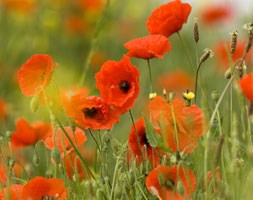
Papaver rhoeas (field poppy) £2.49
Position: full sun Soil: well-drained, preferably poor soil Rate of growth: average Hardiness: fully hardy Once a common sight in cornfields, this brilliant red field poppy is perfect for a sunny wildflower garden or meadow, where it will self-seed freely. Profits from these seeds are used to protect existing wildflower areas and develop new sites where wildflowers can grow. In folklore field poppies were believed to cause thunderstorms. Garden care: When sowing seeds do not use a fertiliser since wildflowers prefer poor soils. In autumn after flowering cut the faded flower-heads down to the ground and compost the dead stems. Sow: March-May or September-October Flowering: August-September or May-July Approximate quantity: 5000 seeds.
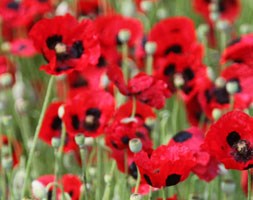
Papaver commutatum (Caucasian scarlet poppy) £0.99
Position: full sun Soil: well-drained, preferably poor soil Rate of growth: average Flowering period: June to August Hardiness: hardy annual The upright stems carrying the flower buds snake up from amongst softly hairy grey-green foliage in summer and split open to reveal deep red petals, each with a black spot at its base. These vibrant flowers form big bowls of colour, and as the petals drop, the ground beneath becomes a vivid carpet. Garden care: They tend to resent root disturbance, so sow shallowly, directly into a well prepared bed in spring and water well. As the seedlings develop, thin them out to 30cm intervals keeping just the healthiest and most robust plants. When watering, give the plants a really thorough soak when the soil gets dry, rather than a little water every day. Dead-heading will prolong the flowering period, but at the end of the season you should let some seed heads to develop for next years crop. Sow: March-May Flowering: June-August Approximate quantity: 1000 seeds.
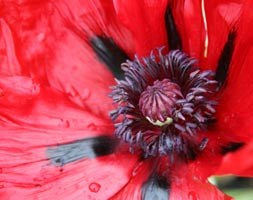
Papaver orientale ‘(Goliath Group) Beauty of Livermere’ (poppy) £4.99
Position: full sun Soil: moist, well-drained Rate of growth: fast-growing Flowering period: May to July Hardiness: fully hardy A really exuberant oriental poppy, with sumptuous, large pillar-box red flowers in early summer and downy, mid green leaves. The silky tissue- paper petals of this tall, strong-stemmed poppy are splashed with black and each flower has a dark, velvety centre. Although the flowers of all oriental poppies are ephemeral, they are easy to grow, bring a zing to any planting scheme and each plant will produce several flowers. It cut back after flowering, they may even produce a second flush. Plant in a sunny border, alongside grasses or late summer-flowering perennials, such as dahlias, which will provide interest when the plant has died back. Garden care: Cut back to ground level after flowering. Lift and divide large clumps in autumn.
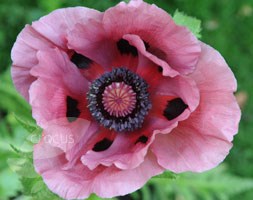
Papaver orientale ‘Harlem’ (New York Series) (oriental poppy) £9.99
Position: full sun Soil: moist, well-drained Rate of growth: fast growing Flowering period: May to June Flower colour: burgundy-pink Other features: dried seed heads are useful for flower arrangements Hardiness: fully hardy A big hit at this years (2011) Chesea Flower Show, where it was featured in Luciano Giubbilei’s garden for Laurent Perrier, this oriental poppy has big, blowsy burgundy-pink flowers. It is an easy to grow plant, producing early summer colour, and later decorative seedheads. Garden care: Cut back to ground level after flowering. Lift and divide large clumps in autumn
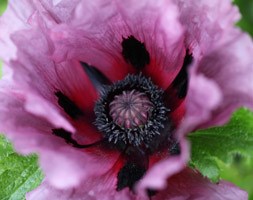
Papaver orientale ‘Patty’s Plum’ (oriental poppy) £5.99
Position: full sun/part-shade Soil: moist, well-drained Rate of growth: fast-growing Flowering period: May to July Hardiness: fully hardy A really luscious oriental poppy with deep reddish-purple flowers in early summer and bristly, grey-green leaves. The silky, pleated petals of this popular variety have been compared to the faded silk of antique ball gowns. Although the flowers of all oriental poppies are ephemeral, they are easy to grow and each plant will produce several flowers. If cut back after flowering, they may even produce a second flush. Plant it in a sunny border, as part of a cottage-garden scheme, alongside grasses or late summer-flowering perennials, such as dahlias, which will provide interest when the plant has died back. ‘Patty’s Plum’ contrasts particularly well with silver foliage plants. It will need staking, as it has a tendance to sprawl. Garden care: Cut back to ground level after flowering. Lift and divide large clumps in autumn.

Papaver orientale ‘Patty’s Plum’ (oriental poppy) £7.99
Position: full sun/part-shade Soil: moist, well-drained Rate of growth: fast-growing Flowering period: May to July Hardiness: fully hardy A really luscious oriental poppy with deep reddish-purple flowers in early summer and bristly, grey-green leaves. The silky, pleated petals of this popular variety have been compared to the faded silk of antique ball gowns. Although the flowers of all oriental poppies are ephemeral, they are easy to grow and each plant will produce several flowers. If cut back after flowering, they may even produce a second flush. Plant it in a sunny border, as part of a cottage-garden scheme, alongside grasses or late summer-flowering perennials, such as dahlias, which will provide interest when the plant has died back. ‘Patty’s Plum’ contrasts particularly well with silver foliage plants. It will need staking, as it has a tendance to sprawl. Garden care: Cut back to ground level after flowering. Lift and divide large clumps in autumn.
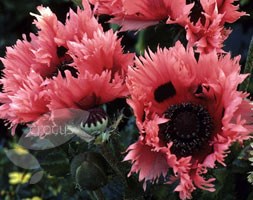
Papaver orientale ‘Pink Ruffles’ (PBR) (oreintal poppy) £7.99
Position: full sun Soil: moist, well-drained Rate of growth: fast growing Flowering period: May to June Flower colour: apricot-pink Other features: dried seed heads are useful for flower arrangements Hardiness: fully hardy Each orange-flushed, pink petal has a dark plum blotch at its base. These surround a near-black centre with a cluster of stamens, forming very attractive, semi-double flowers, which appear in abundance providing a wonderful contrast to deep shades of plum and purple. Garden care: Cut back to ground level after flowering. Lift and divide large clumps in autumn
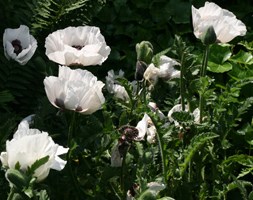
Papaver orientale ‘Royal Wedding’ (oriental poppy) £7.99
Position: full sun Soil: moist, well-drained Rate of growth: fast-growing Flowering period: May to July Flower colour: white with a black blotch Other features: dried seed-heads are useful for flower arrangements Hardiness: fully hardy Exquisite, white flowers each with a black centre, top downy, upright stems in early summer. This striking oriental poppy will flourish in any sunny, well drained border, however it looks particularly good in a contemporary setting where the colour range has been restricted to whites and silvers. Garden care: Cut back to ground level after flowering. Lift and divide large clumps in autumn.
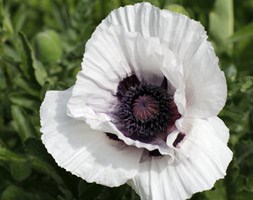
Papaver orientale ‘Royal Wedding’ (poppy Royal Wedding) £4.99
Position: full sun Soil: moist, well-drained Rate of growth: fast-growing Flowering period: May to July Flower colour: white with a black blotch Other features: dried seed-heads are useful for flower arrangements Hardiness: fully hardy Exquisite, white flowers each with a black centre, top downy, upright stems in early summer. This striking oriental poppy will flourish in any sunny, well drained border, however it looks particularly good in a contemporary setting where the colour range has been restricted to whites and silvers. Garden care: Cut back to ground level after flowering. Lift and divide large clumps in autumn.
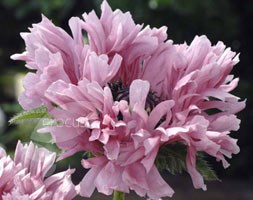
Papaver orientale ‘Ruffled Patty’ (PBR) (oreintal poppy) £7.99
Position: full sun Soil: moist, well-drained Rate of growth: fast growing Flowering period: May to June Flower colour: lilac-pink Other features: dried seed heads are useful for flower arrangements Hardiness: fully hardy Stout, bristly stems are topped with rounded green buds, which open to large, lilac-pink flowers that are often streaked with a rich shade of crimson towards the base of the petals. Standing up well to inclement weather, this magnificent cultivar rarely needs staking. Garden care: Cut back to ground level after flowering. Lift and divide large clumps in autumn
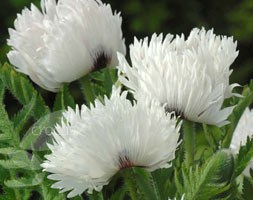
Papaver orientale ‘White Ruffles’ (PBR) (oriental poppy) £7.99
Position: full sun Soil: moist, well-drained Rate of growth: fast growing Flowering period: May to June Flower colour: white Other features: dried seed heads are useful for flower arrangements Hardiness: fully hardy Frilly-looking white flowers with a darkly contrasting base, appear on leafy, upright stems above the clumps of basal foliage creating textural interest in the border. After the petals have fallen, promptly cutting back the entire stem may encourage more flowers to form. Garden care: Cut back to ground level after flowering. Lift and divide large clumps in autumn
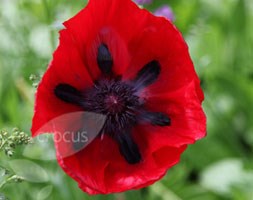
Papaver orientale (Goliath Group) ‘Beauty of Livermere’ (oriental poppy) £7.99
Position: full sun Soil: moist, well-drained Rate of growth: fast-growing Flowering period: May to July Hardiness: fully hardy A really exuberant oriental poppy, with sumptuous, large pillar-box red flowers in early summer and downy, mid green leaves. The silky tissue- paper petals of this tall, strong-stemmed poppy are splashed with black and each flower has a dark, velvety centre. Although the flowers of all oriental poppies are ephemeral, they are easy to grow, bring a zing to any planting scheme and each plant will produce several flowers. It cut back after flowering, they may even produce a second flush. Plant in a sunny border, alongside grasses or late summer-flowering perennials, such as dahlias, which will provide interest when the plant has died back. Garden care: Cut back to ground level after flowering. Lift and divide large clumps in autumn.
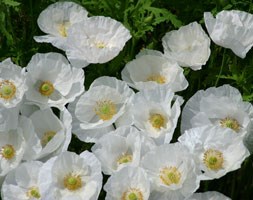
Papaver rhoeas ‘Bridal Silk’ (field poppy) £2.49
Position: full sun Soil: well-drained, preferably poor soil Rate of growth: average Flowering period: June to August Hardiness: hardy annual The crumpled petals of this sublime poppy are mainly white, but sometimes have a faint pink blush. They top the slender wiry stems that rise above the rosettes of foliage from early summer forming bowl-shaped blooms, which flutter like butterflies in the breeze. At their best when planted in big drifts, they also make wonderful, if somewhat short-lived cut flowers. Garden care: They tend to resent root disturbance, so sow shallowly, directly into a well prepared bed in spring and water well. As the seedlings develop, thin them out to 30cm intervals keeping just the healthiest and most robust plants. When watering, give the plants a really thorough soak when the soil gets dry, rather than a little water every day. Dead-heading will prolong the flowering period, but at the end of the season you should let some seed heads to develop for next years crop. Sow: March-May Flowering: June-August Approximate quantity: 500 seeds.
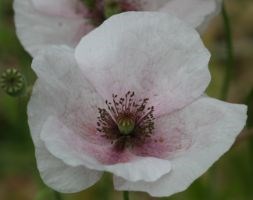
Papaver rhoeas ‘Fairy Wings’ (mixed) (field poppy) £1.49
Position: full sun Soil: well-drained, preferably poor soil Rate of growth: average Flowering period: June to August Hardiness: hardy annual An array of pink, white and lilac shades, which all have metallic-blue undertones, the flowers of this field poppy appear like luminous butterflies on top of the slender, hairy stems. Long after the last petal has fluttered away on the breeze, the seed-heads will continue to add a decorative touch to the border. Garden care: They tend to resent root disturbance, so sow shallowly, directly into a well prepared bed in spring and water well. As the seedlings develop, thin them out to 30cm intervals keeping just the healthiest and most robust plants. When watering, give the plants a really thorough soak when the soil gets dry, rather than a little water every day. Dead-heading will prolong the flowering period, but at the end of the season you should let some seed heads to develop for next years crop. Sow: March-May Flowering: June-August Approximate quantity: 1000 seeds.
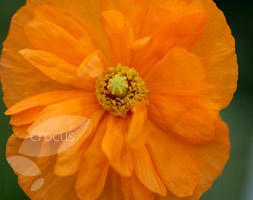
Papaver rupifragum ‘Tangerine Parfait’ (poppy) £2.99
Position: full sun Soil: well-drained, preferably poor soil Rate of growth: average Flowering period: June to August Hardiness: fully hardy (but short-lived) A prolific bloomer, producing soft tangerine flowers throughout the summer. A short-lived perennial, it will self-seed freely in the right conditions. It is brilliant for scattering through a sunny border, and it also works well in pots and windowboxes. After the double flowers have faded the seedpods will remain interesting for several months and can be dried and added to everlasting arrangements. Garden care: They tend to resent root disturbance, so sow shallowly, directly into a well prepared bed in spring and water well. As the seedlings develop, thin them out to 30cm intervals keeping just the healthiest and most robust plants. Protect the emerging seedlings from slugs and snails. The seedheads can be dried and added to winter arrangements. Sow: March-May Flowering: June-August Approximate quantity: 150 seeds.
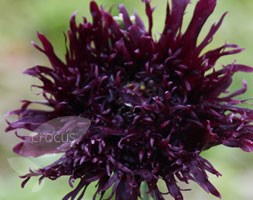
Papaver somniferum ‘Blackcurrant Fizz’ (opium poppy) £2.49
Position: full sun Soil: well-drained, preferably poor soil Rate of growth: average Flowering period: June to August Hardiness: hardy annual An easy to grow annual that produces a wonderful display when its distinctive, deep burgundy flowers appear throughout summer. The flowers shredded appearance will add textural interest to the border, while their brooding colour adds depth and warmth. Plant them in generous swathes and mix them with rich purple, orange and gold. Garden care: They tend to resent root disturbance, so sow shallowly, directly into a well prepared bed in spring and water well. As the seedlings develop, thin them out to 30cm intervals keeping just the healthiest and most robust plants. Protect the emerging seedlings from slugs and snails. The seedheads can be dried and added to winter arrangements. Sow: March-May Flowering: June-August Approximate quantity: 200 seeds
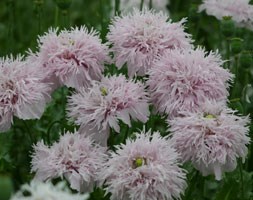
Papaver somniferum ‘Lilac Pompom’ (opium poppy) £2.49
Position: full sun Soil: well-drained, preferably poor soil Rate of growth: average Flowering period: June to August Hardiness: hardy annual Super-sized, fully double flowers with a frilly, somewhat shredded appearance top the stout bristly stems throughout summer. A beautiful addition to cottage gardens, it blends beautifully with most shades of pink, purple and plum. After the petals fall, attractive seedheads develop, which will remain interesting well into autumn. Garden care: They tend to resent root disturbance, so sow shallowly, directly into a well prepared bed in spring and water well. As the seedlings develop, thin them out to 30cm intervals keeping just the healthiest and most robust plants. Protect the emerging seedlings from slugs and snails. The seedheads can be dried and added to winter arrangements. Sow: March-May Flowering: June-August Approximate quantity: 200 seeds.
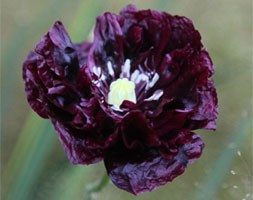
Papaver somniferum (Paeoniiflorum Group) ‘Black Paeony’ (poppy) £1.99
Position: full sun Soil: well-drained, preferably poor soil Rate of growth: average Flowering period: June to August Hardiness: hardy annual Fantastically large flowerheads are packed with dark plum (almost black), crumpled petals, which give the flower a frilly effect. These magnificent blooms sit on top of stout stems in summer and as the petals fall, attractive seed heads remain, which will add interest to the border for several months. Garden care: They tend to resent root disturbance, so sow shallowly, directly into a well prepared bed in spring and water well. As the seedlings develop, thin them out to 30cm intervals keeping just the healthiest and most robust plants. Protect the emerging seedlings from slugs and snails. The seedheads can be dried and added to winter arrangements. Sow: March-May Flowering: June-August Approximate quantity: 150 seeds.
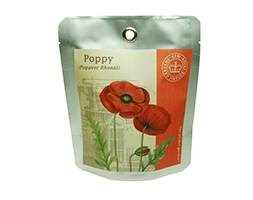
Poppy – pocket garden £5.99
Poppies are exceptionally beautiful flowers that have translucent petals, which seem to glow when backlit by the sun. The seeds come in a decorative foil growing pouch that can sill on a sunny windowsill, with easy to follow sowing instructions and a sturdy cardboard tag, which can be used as a label.

Poppy field collection of annuals (poppy field collection) £3.99
Position: full sun Soil:well drained, reasonably poor soil Rate of growth: average Hardiness: fully hardy Fields of wildflowers were common until 40 years ago and due to their fantastic impact and ease of growth, they are making a welcome return. In this collection, the scarlet waves of poppies mingle with the pinks of corncockle and the blue cornflower. The butterflies love these plants so will flock to your garden creating a wildlife haven. These plants are annuals so will only last one year, but if you dont remove the flowers after they have faded they will usually scatter their seeds for further crops in subsequent years. Each packet will cover around 5sqm. Collection Contains Corncockle – Agrostemma githago – Mauve Cornflower – Centaurea cyanus – Blue Field Poppy – Papaver rhoeas Sow: March – May or September – October Flowering: August – September or May – July Approximate quantity: 2200 seeds.






